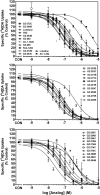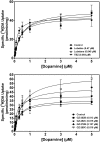Phenyl ring-substituted lobelane analogs: inhibition of [³H]dopamine uptake at the vesicular monoamine transporter-2
- PMID: 20876747
- PMCID: PMC3061534
- DOI: 10.1124/jpet.110.172882
Phenyl ring-substituted lobelane analogs: inhibition of [³H]dopamine uptake at the vesicular monoamine transporter-2
Abstract
Lobeline attenuates the behavioral effects of methamphetamine via inhibition of the vesicular monoamine transporter (VMAT2). To increase selectivity for VMAT2, chemically defunctionalized lobeline analogs, including lobelane, were designed to eliminate nicotinic acetylcholine receptor affinity. The current study evaluated the ability of lobelane analogs to inhibit [³H]dihydrotetrabenazine (DTBZ) binding to VMAT2 and [³H]dopamine (DA) uptake into isolated synaptic vesicles and determined the mechanism of inhibition. Introduction of aromatic substituents in lobelane maintained analog affinity for the [³H]DTBZ binding site on VMAT2 and inhibitory potency in the [³H]DA uptake assay assessing VMAT2 function. The most potent (K(i) = 13-16 nM) analogs in the series included para-methoxyphenyl nor-lobelane (GZ-252B), para-methoxyphenyl lobelane (GZ-252C), and 2,4-dichlorphenyl lobelane (GZ-260C). Affinity of the analogs for the [³H]DTBZ binding site did not correlate with inhibitory potency in the [³H]DA uptake assay. It is noteworthy that the N-benzylindole-, biphenyl-, and indole-bearing meso-analogs 2,6-bis[2-(1-benzyl-1H-indole-3-yl)ethyl]-1-methylpiperidine hemifumarate (AV-1-292C), 2,6-bis(2-(biphenyl-4-yl)ethyl)piperidine hydrochloride (GZ-272B), and 2,6-bis[2-(1H-indole-3-yl)ethyl]-1-methylpiperidine monofumarate (AV-1-294), respectively] inhibited VMAT2 function (K(i) = 73, 127, and 2130 nM, respectively), yet had little to no affinity for the [³H]DTBZ binding site. These results suggest that the analogs interact at an alternate site to DTBZ on VMAT2. Kinetic analyses of [³H]DA uptake revealed a competitive mechanism for 2,6-bis(2-(4-methoxyphenyl)ethyl)piperidine hydrochloride (GZ-252B), 2,6-bis(2-(4-methoxyphenyl)ethyl)-1-methylpiperidine hydrochloride (GZ-252C), 2,6-bis(2-(2,4-dichlorophenyl)ethyl)piperidine hydrochloride (GZ-260C), and GZ-272B. Similar to methamphetamine, these analogs released [³H]DA from the vesicles, but with higher potency. In contrast to methamphetamine, these analogs had higher potency (>100-fold) at VMAT2 than DAT, predicting low abuse liability. Thus, modification of the lobelane molecule affords potent, selective inhibitors of VMAT2 function and reveals two distinct pharmacological targets on VMAT2.
Figures








Similar articles
-
Novel N-1,2-dihydroxypropyl analogs of lobelane inhibit vesicular monoamine transporter-2 function and methamphetamine-evoked dopamine release.J Pharmacol Exp Ther. 2011 Oct;339(1):286-97. doi: 10.1124/jpet.111.184770. Epub 2011 Jul 21. J Pharmacol Exp Ther. 2011. PMID: 21778282 Free PMC article.
-
Lobelane inhibits methamphetamine-evoked dopamine release via inhibition of the vesicular monoamine transporter-2.J Pharmacol Exp Ther. 2010 Feb;332(2):612-21. doi: 10.1124/jpet.109.160275. Epub 2009 Oct 23. J Pharmacol Exp Ther. 2010. PMID: 19855096 Free PMC article.
-
The vesicular monoamine transporter-2: an important pharmacological target for the discovery of novel therapeutics to treat methamphetamine abuse.Adv Pharmacol. 2014;69:71-106. doi: 10.1016/B978-0-12-420118-7.00002-0. Adv Pharmacol. 2014. PMID: 24484975 Free PMC article. Review.
-
Defunctionalized lobeline analogues: structure-activity of novel ligands for the vesicular monoamine transporter.J Med Chem. 2005 Aug 25;48(17):5551-60. doi: 10.1021/jm0501228. J Med Chem. 2005. PMID: 16107155 Free PMC article.
-
Design, synthesis and interaction at the vesicular monoamine transporter-2 of lobeline analogs: potential pharmacotherapies for the treatment of psychostimulant abuse.Curr Top Med Chem. 2011;11(9):1103-27. doi: 10.2174/156802611795371332. Curr Top Med Chem. 2011. PMID: 21050177 Free PMC article. Review.
Cited by
-
meso-Transdiene analogs inhibit vesicular monoamine transporter-2 function and methamphetamine-evoked dopamine release.J Pharmacol Exp Ther. 2011 Mar;336(3):940-51. doi: 10.1124/jpet.110.175117. Epub 2010 Dec 21. J Pharmacol Exp Ther. 2011. PMID: 21177475 Free PMC article.
-
Exploring the effect of N-substitution in nor-lobelane on the interaction with VMAT2: discovery of a potential clinical candidate for treatment of methamphetamine abuse.Medchemcomm. 2013 Mar;4(3):564-568. doi: 10.1039/C3MD20374C. Medchemcomm. 2013. PMID: 23527317 Free PMC article.
-
Fluoroethoxy-1,4-diphenethylpiperidine and piperazine derivatives: Potent and selective inhibitors of [3H]dopamine uptake at the vesicular monoamine transporter-2.Bioorg Med Chem Lett. 2017 Dec 15;27(24):5467-5472. doi: 10.1016/j.bmcl.2017.10.039. Epub 2017 Oct 20. Bioorg Med Chem Lett. 2017. PMID: 29153425 Free PMC article.
-
GZ-793A, a lobelane analog, interacts with the vesicular monoamine transporter-2 to inhibit the effect of methamphetamine.J Neurochem. 2013 Oct;127(2):177-86. doi: 10.1111/jnc.12371. Epub 2013 Aug 19. J Neurochem. 2013. PMID: 23875622 Free PMC article.
-
GZ-793A inhibits the neurochemical effects of methamphetamine via a selective interaction with the vesicular monoamine transporter-2.Eur J Pharmacol. 2017 Jan 15;795:143-149. doi: 10.1016/j.ejphar.2016.12.016. Epub 2016 Dec 13. Eur J Pharmacol. 2017. PMID: 27986625 Free PMC article.
References
-
- Andersen PH. (1987) Biochemical and pharmacological characterization of [3H]GBR 12935 binding in vitro to rat striatal membranes: labeling of the dopamine uptake complex. J Neurochem 48:1887–1896 - PubMed
-
- Briggs CA, McKenna DG. (1998) Activation and inhibition of the human α7 nicotinic acetylcholine receptor by agonists. Neuropharmacology 37:1095–1102 - PubMed
-
- Brown JM, Hanson GR, Fleckenstein AE. (2000) Methamphetamine rapidly decreases vesicular dopamine uptake. J Neurochem 74:2221–2223 - PubMed
-
- Cheng Y, Prusoff WH. (1973) Relationship between the inhibition constant (K1) and the concentration of inhibitor which causes 50 per cent inhibition (I50) of an enzymatic reaction. Biochem Pharmacol 22:3099–3108 - PubMed
-
- Decker MW, Majchrzak MJ, Arnerić SP. (1993) Effects of lobeline, a nicotinic receptor agonist, on learning and memory. Pharmacol Biochem Behav 45:571–576 - PubMed
Publication types
MeSH terms
Substances
Grants and funding
LinkOut - more resources
Full Text Sources
Miscellaneous

